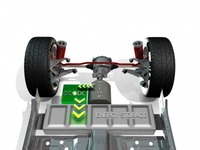Prodrive leads breakthrough in DC-DC converter technology
 A new approach to the configuration of DC-DC converters will help to reduce the cost, weight and package space associated with electric vehicle battery packs. Developed by a consortium led by technology consultancy Prodrive, the system addresses the spiralling costs of energy storage by substantially increasing the voltage available at the traction motors.
A new approach to the configuration of DC-DC converters will help to reduce the cost, weight and package space associated with electric vehicle battery packs. Developed by a consortium led by technology consultancy Prodrive, the system addresses the spiralling costs of energy storage by substantially increasing the voltage available at the traction motors.To improve efficiency, electric motors require ever wider speed ranges; as speed is proportional to voltage, electric vehicles and hybrids are progressing from 300v to 600v systems. This creates a significant challenge because battery chemistry dictates the voltage per cell, so doubling the voltage with the same battery chemistry means doubling the number of cells, incurring massive cost, weight and packaging penalties. More cells, or a switch to an alternative chemistry, may also exacerbate challenges such asthermal management, availability, environmental protection and end-of-life recycling.
To address this challenge, the consortium (which as well as Prodrive includes the University of Manchester, HILTech Developments, Sloan Electronics Ltd, International Transformers and Newcastle University) has developed a new type of bi-directional DC-DC converter that gives a 600v output from a 380v source and maintains its output even when the source voltage drops to as little as 200v. The key is an innovative new topology that delivers up to 97 percent efficiency and, unlike alternative solutions, is also low cost and extremely compact. The power handling capability is scalable, with development units rated at 50kW for full hybrid applications.
“DC-DC converters are widely used to drop battery pack voltage (eg 300v) down to vehicle system voltage (13.8v), but we believe this is the first time that a substantial step the other way has been possible from a realistically priced and packaged technology,” explains Prodrive’s technical specialist, Pete James. “With a unit that is a quarter the size of a conventional converter, we can eliminate 20 percent of the vehicle’s batteries, and possibly more.”
James considers the move to higher voltages to be the EV equivalent of engine downsizing: a technique that is increasingly important for the reduction of emissions from internal combustion engines. “It’s expensive and inefficient to carry around the huge battery pack that you only need for maximum motor speeds,” he says. “With our solution you don’t have to, yet maximum voltage is available whenever it is needed.”
The new converter brings additional benefits too. The voltage of batteries (and fuel cells and supercapacitors) can fluctuate with changing load, but the Prodrive converter always presents the full voltage required by the motor. Vehicle architecture benefits from a reduced battery pack envelope and weight, and there is an overall cost saving. “A normal DC-DC converter would cost more than the saving in batteries but our unit potentially saves four times its own cost in batteries,” says James.
Prodrive has built a considerable reputation as a centre of excellence for the integration of future powertrains by concentrating on control systems and techniques for efficiency enhancement. “It’s all about managing the energy flow through the vehicle,” concludes James. “There are so many efficiency pitfalls when moving energy between chemical, electrical and kinetic states. Our whole-vehicle perspective means that we work well with specialist technology suppliers; we see the overall picture. That’s the only way to get real value from innovation.”
Working from technical centres in the UK, US and Australia, Prodrive provides design, development and manufacturing support for a wide range of vehicle programmes. Its expertise in control systems, transmissions, carbon composites and ultra-high precision small batch manufacturing is also increasingly called upon to solve problems across a wide range of other industries, where the company’s ability to deliver outstanding solutions extremely quickly has put its products in oil rigs, aircraft, yachts, satellites and, via its own global motorsport operations, many of the most successful competition cars ever created.

